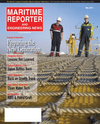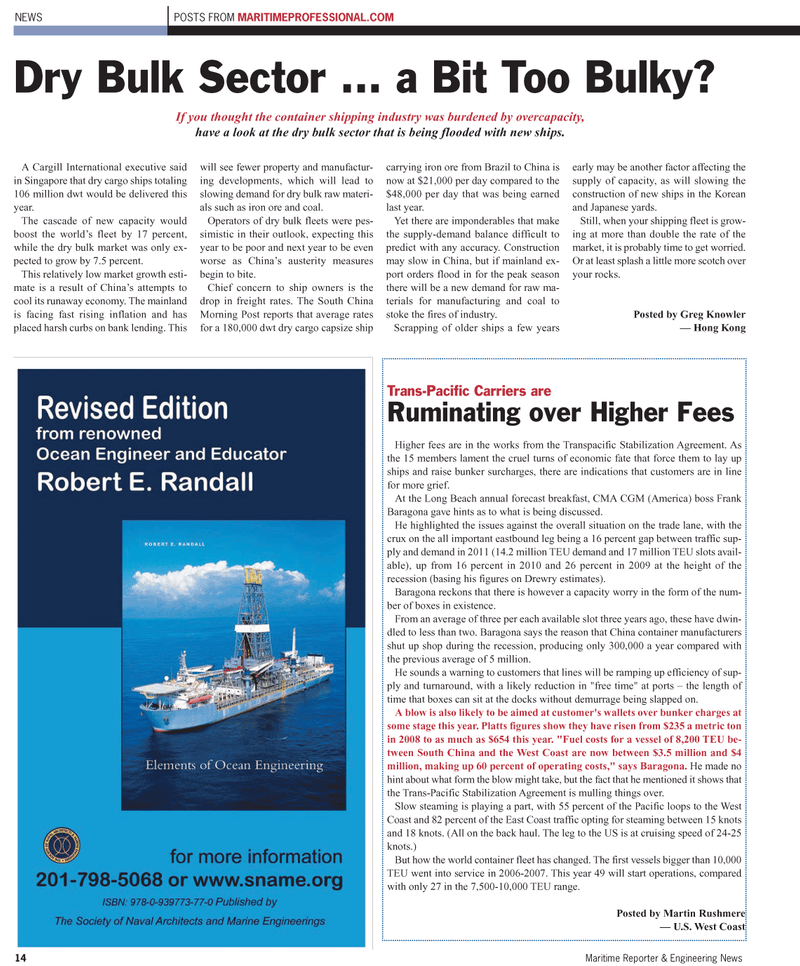
Page 14: of Maritime Reporter Magazine (May 2011)
Training & Education Edition
Read this page in Pdf, Flash or Html5 edition of May 2011 Maritime Reporter Magazine
A Cargill International executive said in Singapore that dry cargo ships totaling 106 million dwt would be delivered this year.
The cascade of new capacity would boost the world’s fleet by 17 percent, while the dry bulk market was only ex- pected to grow by 7.5 percent.
This relatively low market growth esti- mate is a result of China’s attempts to cool its runaway economy. The mainland is facing fast rising inflation and has placed harsh curbs on bank lending. This will see fewer property and manufactur- ing developments, which will lead to slowing demand for dry bulk raw materi- als such as iron ore and coal.
Operators of dry bulk fleets were pes- simistic in their outlook, expecting this year to be poor and next year to be even worse as China’s austerity measures begin to bite.
Chief concern to ship owners is the drop in freight rates. The South China
Morning Post reports that average rates for a 180,000 dwt dry cargo capsize ship carrying iron ore from Brazil to China is now at $21,000 per day compared to the $48,000 per day that was being earned last year.
Yet there are imponderables that make the supply-demand balance difficult to predict with any accuracy. Construction may slow in China, but if mainland ex- port orders flood in for the peak season there will be a new demand for raw ma- terials for manufacturing and coal to stoke the fires of industry.
Scrapping of older ships a few years early may be another factor affecting the supply of capacity, as will slowing the construction of new ships in the Korean and Japanese yards.
Still, when your shipping fleet is grow- ing at more than double the rate of the market, it is probably time to get worried.
Or at least splash a little more scotch over your rocks.
Posted by Greg Knowler — Hong Kong 14 Maritime Reporter & Engineering News
NEWS POSTS FROM MARITIMEPROFESSIONAL.COM
Dry Bulk Sector ... a Bit Too Bulky?
If you thought the container shipping industry was burdened by overcapacity, have a look at the dry bulk sector that is being flooded with new ships.
Trans-Pacific Carriers are
Ruminating over Higher Fees
Higher fees are in the works from the Transpacific Stabilization Agreement. As the 15 members lament the cruel turns of economic fate that force them to lay up ships and raise bunker surcharges, there are indications that customers are in line for more grief.
At the Long Beach annual forecast breakfast, CMA CGM (America) boss Frank
Baragona gave hints as to what is being discussed.
He highlighted the issues against the overall situation on the trade lane, with the crux on the all important eastbound leg being a 16 percent gap between traffic sup- ply and demand in 2011 (14.2 million TEU demand and 17 million TEU slots avail- able), up from 16 percent in 2010 and 26 percent in 2009 at the height of the recession (basing his figures on Drewry estimates).
Baragona reckons that there is however a capacity worry in the form of the num- ber of boxes in existence.
From an average of three per each available slot three years ago, these have dwin- dled to less than two. Baragona says the reason that China container manufacturers shut up shop during the recession, producing only 300,000 a year compared with the previous average of 5 million.
He sounds a warning to customers that lines will be ramping up efficiency of sup- ply and turnaround, with a likely reduction in "free time" at ports – the length of time that boxes can sit at the docks without demurrage being slapped on.
A blow is also likely to be aimed at customer's wallets over bunker charges at some stage this year. Platts figures show they have risen from $235 a metric ton in 2008 to as much as $654 this year. "Fuel costs for a vessel of 8,200 TEU be- tween South China and the West Coast are now between $3.5 million and $4 million, making up 60 percent of operating costs," says Baragona. He made no hint about what form the blow might take, but the fact that he mentioned it shows that the Trans-Pacific Stabilization Agreement is mulling things over.
Slow steaming is playing a part, with 55 percent of the Pacific loops to the West
Coast and 82 percent of the East Coast traffic opting for steaming between 15 knots and 18 knots. (All on the back haul. The leg to the US is at cruising speed of 24-25 knots.)
But how the world container fleet has changed. The first vessels bigger than 10,000
TEU went into service in 2006-2007. This year 49 will start operations, compared with only 27 in the 7,500-10,000 TEU range.
Posted by Martin Rushmere — U.S. West Coast

 13
13

 15
15
